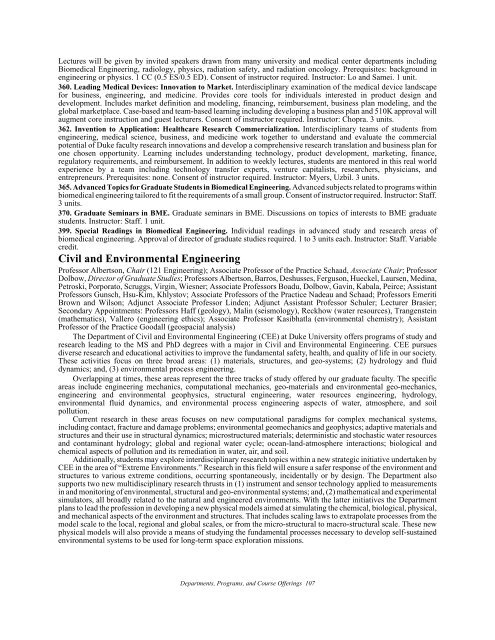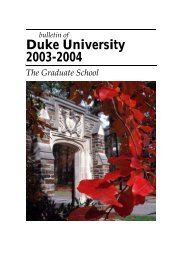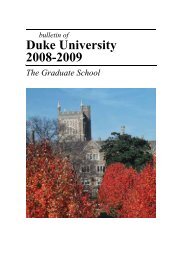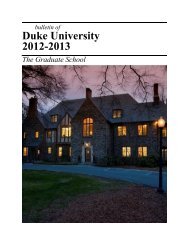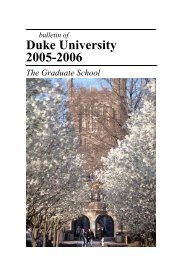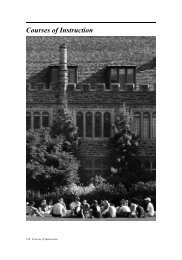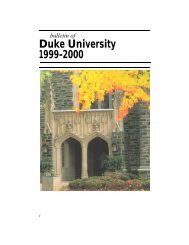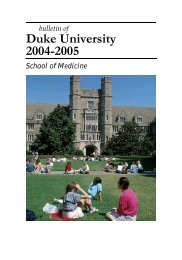Duke University 2009-2010 - Office of the Registrar - Duke University
Duke University 2009-2010 - Office of the Registrar - Duke University
Duke University 2009-2010 - Office of the Registrar - Duke University
You also want an ePaper? Increase the reach of your titles
YUMPU automatically turns print PDFs into web optimized ePapers that Google loves.
Lectures will be given by invited speakers drawn from many university and medical center departments including<br />
Biomedical Engineering, radiology, physics, radiation safety, and radiation oncology. Prerequisites: background in<br />
engineering or physics. 1 CC (0.5 ES/0.5 ED). Consent <strong>of</strong> instructor required. Instructor: Lo and Samei. 1 unit.<br />
360. Leading Medical Devices: Innovation to Market. Interdisciplinary examination <strong>of</strong> <strong>the</strong> medical device landscape<br />
for business, engineering, and medicine. Provides core tools for individuals interested in product design and<br />
development. Includes market definition and modeling, financing, reimbursement, business plan modeling, and <strong>the</strong><br />
global marketplace. Case-based and team-based learning including developing a business plan and 510K approval will<br />
augment core instruction and guest lecturers. Consent <strong>of</strong> instructor required. Instructor: Chopra. 3 units.<br />
362. Invention to Application: Healthcare Research Commercialization. Interdisciplinary teams <strong>of</strong> students from<br />
engineering, medical science, business, and medicine work toge<strong>the</strong>r to understand and evaluate <strong>the</strong> commercial<br />
potential <strong>of</strong> <strong>Duke</strong> faculty research innovations and develop a comprehensive research translation and business plan for<br />
one chosen opportunity. Learning includes understanding technology, product development, marketing, finance,<br />
regulatory requirements, and reimbursement. In addition to weekly lectures, students are mentored in this real world<br />
experience by a team including technology transfer experts, venture capitalists, researchers, physicians, and<br />
entrepreneurs. Prerequisites: none. Consent <strong>of</strong> instructor required. Instructor: Myers, Uzbil. 3 units.<br />
365. Advanced Topics for Graduate Students in Biomedical Engineering. Advanced subjects related to programs within<br />
biomedical engineering tailored to fit <strong>the</strong> requirements <strong>of</strong> a small group. Consent <strong>of</strong> instructor required. Instructor: Staff.<br />
3 units.<br />
370. Graduate Seminars in BME. Graduate seminars in BME. Discussions on topics <strong>of</strong> interests to BME graduate<br />
students. Instructor: Staff. 1 unit.<br />
399. Special Readings in Biomedical Engineering. Individual readings in advanced study and research areas <strong>of</strong><br />
biomedical engineering. Approval <strong>of</strong> director <strong>of</strong> graduate studies required. 1 to 3 units each. Instructor: Staff. Variable<br />
credit.<br />
Civil and Environmental Engineering<br />
Pr<strong>of</strong>essor Albertson, Chair (121 Engineering); Associate Pr<strong>of</strong>essor <strong>of</strong> <strong>the</strong> Practice Schaad, Associate Chair; Pr<strong>of</strong>essor<br />
Dolbow, Director <strong>of</strong> Graduate Studies; Pr<strong>of</strong>essors Albertson, Barros, Deshusses, Ferguson, Hueckel, Laursen, Medina,<br />
Petroski, Porporato, Scruggs, Virgin, Wiesner; Associate Pr<strong>of</strong>essors Boadu, Dolbow, Gavin, Kabala, Peirce; Assistant<br />
Pr<strong>of</strong>essors Gunsch, Hsu-Kim, Khlystov; Associate Pr<strong>of</strong>essors <strong>of</strong> <strong>the</strong> Practice Nadeau and Schaad; Pr<strong>of</strong>essors Emeriti<br />
Brown and Wilson; Adjunct Associate Pr<strong>of</strong>essor Linden; Adjunct Assistant Pr<strong>of</strong>essor Schuler; Lecturer Brasier;<br />
Secondary Appointments: Pr<strong>of</strong>essors Haff (geology), Malin (seismology), Reckhow (water resources), Trangenstein<br />
(ma<strong>the</strong>matics), Vallero (engineering ethics); Associate Pr<strong>of</strong>essor Kasibhatla (environmental chemistry); Assistant<br />
Pr<strong>of</strong>essor <strong>of</strong> <strong>the</strong> Practice Goodall (geospacial analysis)<br />
The Department <strong>of</strong> Civil and Environmental Engineering (CEE) at <strong>Duke</strong> <strong>University</strong> <strong>of</strong>fers programs <strong>of</strong> study and<br />
research leading to <strong>the</strong> MS and PhD degrees with a major in Civil and Environmental Engineering. CEE pursues<br />
diverse research and educational activities to improve <strong>the</strong> fundamental safety, health, and quality <strong>of</strong> life in our society.<br />
These activities focus on three broad areas: (1) materials, structures, and geo-systems; (2) hydrology and fluid<br />
dynamics; and, (3) environmental process engineering.<br />
Overlapping at times, <strong>the</strong>se areas represent <strong>the</strong> three tracks <strong>of</strong> study <strong>of</strong>fered by our graduate faculty. The specific<br />
areas include engineering mechanics, computational mechanics, geo-materials and environmental geo-mechanics,<br />
engineering and environmental geophysics, structural engineering, water resources engineering, hydrology,<br />
environmental fluid dynamics, and environmental process engineering aspects <strong>of</strong> water, atmosphere, and soil<br />
pollution.<br />
Current research in <strong>the</strong>se areas focuses on new computational paradigms for complex mechanical systems,<br />
including contact, fracture and damage problems; environmental geomechanics and geophysics; adaptive materials and<br />
structures and <strong>the</strong>ir use in structural dynamics; microstructured materials; deterministic and stochastic water resources<br />
and contaminant hydrology; global and regional water cycle; ocean-land-atmosphere interactions; biological and<br />
chemical aspects <strong>of</strong> pollution and its remediation in water, air, and soil.<br />
Additionally, students may explore interdisciplinary research topics within a new strategic initiative undertaken by<br />
CEE in <strong>the</strong> area <strong>of</strong> “Extreme Environments.” Research in this field will ensure a safer response <strong>of</strong> <strong>the</strong> environment and<br />
structures to various extreme conditions, occurring spontaneously, incidentally or by design. The Department also<br />
supports two new multidisciplinary research thrusts in (1) instrument and sensor technology applied to measurements<br />
in and monitoring <strong>of</strong> environmental, structural and geo-environmental systems; and, (2) ma<strong>the</strong>matical and experimental<br />
simulators, all broadly related to <strong>the</strong> natural and engineered environments. With <strong>the</strong> latter initiatives <strong>the</strong> Department<br />
plans to lead <strong>the</strong> pr<strong>of</strong>ession in developing a new physical models aimed at simulating <strong>the</strong> chemical, biological, physical,<br />
and mechanical aspects <strong>of</strong> <strong>the</strong> environment and structures. That includes scaling laws to extrapolate processes from <strong>the</strong><br />
model scale to <strong>the</strong> local, regional and global scales, or from <strong>the</strong> micro-structural to macro-structural scale. These new<br />
physical models will also provide a means <strong>of</strong> studying <strong>the</strong> fundamental processes necessary to develop self-sustained<br />
environmental systems to be used for long-term space exploration missions.<br />
Departments, Programs, and Course Offerings 107


